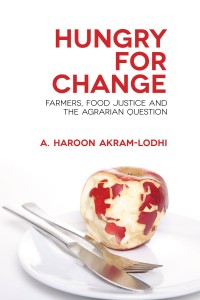Review in the Canadian Journal of Development Studies (2014)

Hungry for Change
Farmers, Food Justice and the Agrarian Question
Hungry for Change: Farmers, Food Justice and the Agrarian Question is a short and sharp book about the global food system and its profound and widespread transformation of the ways in which food is produced, distributed and consumed. The book has nine chapters. It starts with introducing the process of agricultural commercialization, in which money is needed for both producing and buying food. Chapter 2 explains the process of rural capitalist development, reviewing the classical literature of agrarian differentiation and primitive accumulation. Chapter 3 continues by describing how capitalism incorporates Third World peasants into profit making, while alienating them from the benefit of their own labour. Chapters 4 and 5 then turn to discuss land reform and capitalism’s induced technological path dependencies through the application of the Green Revolution and biotechnologies. Chapters 6 and 7 expose how large-scale industrial farms and food processing and distributing corporations, notably US-based ones, use that country’s hegemonic position in the global food system to dispossess small-scale peasants around the world, forcing them into export-oriented agriculture. Chapter 8 compares and assesses two contrasting visions for the future of food and farming. On the one hand, the World Bank typifies those that advocate for a deepening of capitalism, while Via Campesina (an international peasant movement) campaigns for food sovereignty on the other. Finally, Chapter 9 proposes an alternative food system, in which food should be considered as public good, unifying different movements under a common objective of food justice. Throughout the book, Akram-Lodhi convincingly demonstrates how market imperatives under the capitalist food system incorporate farmers into the profit-making cycle. The drive to efficiency, as a condition of accumulation, or simply of survival, leads to wealth concentration and dispossession, in which only large-scale mechanized farmers can take advantage of the demand for landless workers, forcing them either toward urban migration or to join a growing process of class differentiation builds on a tradition of agrarian political economy, Akram-Lodhi also uncovers other and broader mechanisms of the global food system. The author convincingly discusses how differentiation occurs not only within the farming sector but also between farmers and other capitalists, with upward and downward linkages along the food commodity chains. These horizontal and vertical processes of differentiation allow a few seed and agrochemical companies, farming conglomerates and distributors to concentrate power, while subsuming farmers into a cycle of dependence and impoverishment, and alienating consumers into addictions to highly caloric, fatty foods of low nutritional value. These result in a number of contradictions, the most notorious of which are persisting world hunger and creeping malnutrition crises, while food production continues to increase. While the above arguments are not new, the way Akram-Lodhi put them together makes for compelling reading. First, the breadth and scope of coverage, from the processes of primitive accumulation and capitalist development to current issues of technological changes and food sovereignty offers a coherent and complete introduction for students of agrarian political economy. Second, the systematic presentation of different perspectives through the life stories of individuals shows how they are interwoven into the fabric of capitalism and how interconnected the food system is. The language is also simple and straightforward, starting with the captivating statistics and analyses. This makes Akram-Lodhi’s message not only relevant to researchers and activists already versed in the topic, but also accessible to a wider public. I believe this is one of the rare books on agrarian issues and the food system that is not only scientifically well documented, but is also successful in its reach beyond an inner circle of specialists to convince a greater audience and, ultimately, have a wider impact. But this quality of synthesis and brevity may also inevitable be one of the book’s weaknesses. First, while explaining how the globalised food system has transformed food, making it cheap and addictive at the expense of nutrition, Akram-Lodhi does not discuss the more complex entanglement of interests beyond those of conglomerates, which have translated into a broad food safety crisis, mounting in both developed and developing countries. Second, while the author provides a convincing critique of the World Bank’s model of capitalist farming, his assessment of Via Campesina’s food sovereignty, notably its neopopulist influence, needs further elaboration if it is to benefit the broader audience, as the rest of the book successfully does. Lastly, and more fundamentally, Akram-Lodhi acknowledges the ecological impact of the global food system, but from industrial, globalised and capitalist agriculture. This would have allowed the book to account for the dependency of capitalist food production on ecosystems, and hence its inherent vulnerability in the current context of environmental change. The author could then have better inserted his valuable analysis into a bigger picture of systemic risks: that socio-ecological stressors (notably biodiversity loss and climate change) could bring this productive but precarious food system to a halt, and prevent a reversion to alternative cultivars and coping strategies, threatening the food security of hundreds of millions more.
— Thi Thu Trang Tran for the _Canadian Journal of Development Studies_ Vol. 35, No. 2, 328-333, 2014

